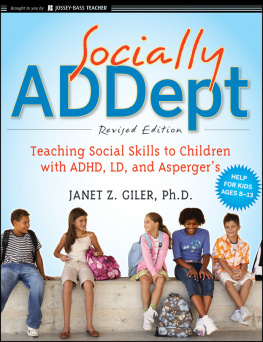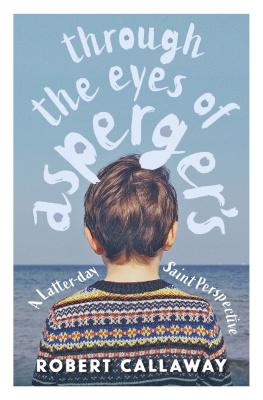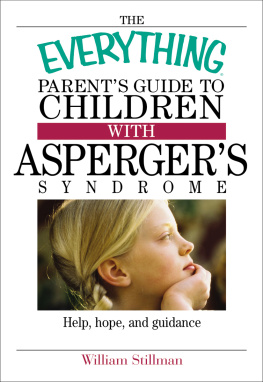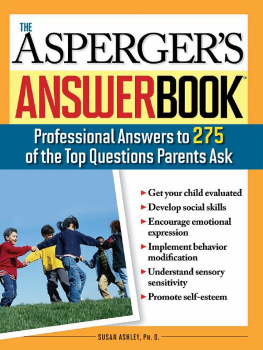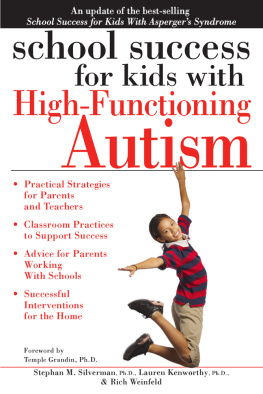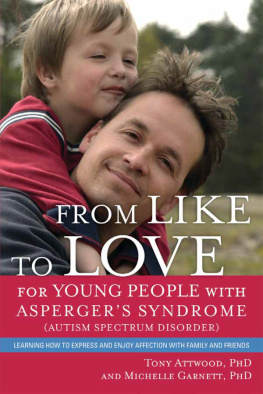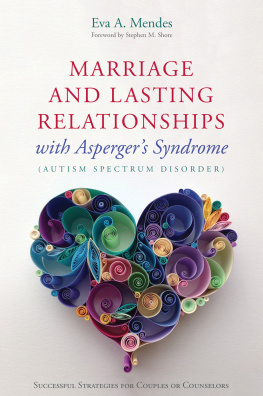school success for kids with
Aspergers
Syndrome
Stephan M. Silverman, Ph.D., &

PRUFROCK PRESS INC.
WACO, TEXAS
Copyright 2007 Prufrock Press Inc.
Edited by Lacy Elwood
Editorial Assistant: Kate Sepanski
Cover and Layout Design by Marjorie Parker
ISBN-13: 978-1-59363-482-7
ISBN-10: 1-59363-482-X
No part of this book may be reproduced, translated, stored in a retrieval system, or transmitted, in any form or by any means, electronic, mechanical, photocopying, microfilming, recording, or otherwise, without written permission from the publisher.
Printed in the United States of America.
At the time of this books publication, all facts and figures cited are the most current available. All telephone numbers, addresses, and Web site URLs are accurate and active. All publications, organizations, Web sites, and other resources exist as described in the book, and all have been verified. The authors and Prufrock Press Inc. make no warranty or guarantee concerning the information and materials given out by organizations or content found at Web sites, and we are not responsible for any changes that occur after this books publication. If you find an error, please contact Prufrock Press Inc.

Prufrock Press Inc.
P.O. Box 8813
Waco, TX 76714-8813
Phone: (800) 998-2208
Fax: (800) 240-0333
http://www.prufrock.com
Dedication
To our parents, Milton and Judith Silverman and Charles and Irene Weinfeld, who gave us the gift of the love of learning and always held high expectations for each of us.
We also would like to dedicate this book to our wives, Karin Silverman and Sara Shelley, in appreciation of their love, support, and patience that made this project possible.
Acknowledgements
We would like to acknowledge Drs. Brenda Smith Myles and Dan Shapiro for their insightful reviews of parts of this book. We would also like to express our gratitude to our editor, Lacy Elwood.
We also would like to acknowledge the many families we have worked with, the school administrators and teachers we have had the privilege to collaborate with, and finally, the students with AS themselves, who provide us with daily inspiration.
Introduction
STANLEY , 13, was sitting at the dinner table across from his grandfather. The table had been cleared and the family had moved to the den to watch a football game. As usual on such evenings, Grandpa engaged Stanley in his favorite topic of interestWorld War II history. Grandpa served in the infantry in Europe and was trying to get a word in edgewise from his memory about a particular campaign, but Stanley was going on and on about the very battle in which Grandpa fought. Finally, Grandpa interrupted Stanley to correct a factual detail. Apparently, Stanley had incorrectly identified the name of the commanding officer on a specific day of the conflict. Even though he took part in the battle, Grandpas memory was shaky. He thought he was right. Stanley went to his room and pulled out a reference book. Stanley was right! There didnt seem to be any thing Stanley didnt know about the war. He continued to reel off fact after fact in a determined, but emotionless, monotone, hardly looking toward his grandfathers face the whole time. Grandpa wanted to share stories of the friends he made and lost in the war, the emotions he felt, and the human drama he experienced, but Stanley seemed only interested in tactical facts and the names of generals. Grandpa wasnt sure that what he thought, knew, or remembered about the war really mattered to Stanley. They werent really connecting. Stanley, like thousands of other children, has Aspergers syndrome (AS), a form of autism.
This book is written for parents, educators, and other professionals who are concerned with providing an education to children like Stanley. It focuses on providing practical strategies that can be used by parents and classroom teachers, and summarizes relevant research in the ever-expanding field of the education of students with Aspergers syndrome. Because a detailed review of research is beyond the scope of this book, we encourage interested readers to refer to the works of the leaders in this field, including Drs. Hans Asperger, Tony Attwood, Simon Baron-Cohen, Mohammad Ghaziuddin, Christopher Gillberg, Ami Klin, Brenda Smith Myles, Sally Ozonoff, Michael Powers, Fred R. Volkmar, and Lorna Wing. If we have omitted the recognition of other pivotal individuals in this area of research and application of knowledge, we apologize. Very few researchers have directly addressed the wide variety of issues involved in general and special education for students with AS. A few notable exceptions in the literature are Drs. Attwood, Ozonoff, Baron-Cohen, Klin, Myles, and Volkmar. Their work, along with that of others, will be discussed briefly in relation to the education of students with Aspergers syndrome in the chapters that follow.
Aspergers syndrome, which we often will refer to as AS, should be recognized as early as possible in the developing child. Not only do we hope that the diagnosis will be applied as early as possible and with accuracy, but we hope that the strengths of each child with AS can be found and supported in the educational environment. The educational experience for children like Stanley should support their zeal and intellectual ability so that learning can be as joyful and productive as the experience is for other children. Children are all born wanting to learn, and the experience of learning should be a happy onestarting with early development until the young person becomes a productive member of society. Because AS is an autistic spectrum disorder, not just a developmental difference or aggregate of eccentricities, children with AS will, at some time in their educational careers, need special approaches to education to learn the facts and skills they are incapable of accessing because of their disability. Special education may not be required in every subject area and skill domain. To whatever extent possible, the child with as should have learning experiences that work for more typically developing children, as long as he or she is deriving meaningful benefit from these learning opportunities and is able to access the curriculum.

To whatever extent possible, the child with As should have learning experiences that work for more typically developing children, as long as he or she is deriving meaningful benefit from these learning opportunities and is able to access the curriculum.

The focus of this book is not only to accept and affirm the humanity of children with AS and aid them in obtaining their right to an education that is consistent with typical development, but also to fill in the gaps where their special needs hamper their ability to access instruction and progress in knowledge. As for children with any disability, the definition of a disability implies the need for additional support in educational areas. However, there is a set of instructional strategies and targeted skill areas beyond the curriculum that require emphasis in order for children with AS to function in a complex and competitive world. We will discuss these strategies and skill areas later in the book.
Next page

